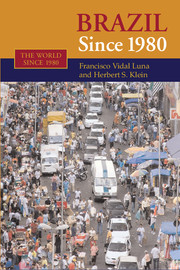Book contents
3 - Financial Sector
Published online by Cambridge University Press: 03 June 2010
Summary
Without question, among the most profound structural changes in the national economy in the past half century has been the creation of a national credit market. For all the early initial development of the financial sector, Brazil in the past quarter century has finally created one of the most sophisticated financial markets in any developing country in the world. It did so amid the shocks of hyperinflation, debt crises, moratoriums, and the entrance of foreign capital institutions. Also, much of the early restructuring of this financial market was at the cost of the public sector, which by the end of the twentieth century finally was able to remove itself from the highly costly subvention, leaving a strong system in place. Although profound problems remain with the ability of the financial sector to provide medium- and long-term private credit and the excessive spread that it obtained in its operations, the financial sector has emerged as a highly liquid, modernized, and technologically advanced system.
When the military seized the government in 1964, the economic authorities identified limitations in the financial sector, which needed to be resolved for the implementation of the ambitious stability and growth program they wished to develop. There was a lack of effective management instruments for an appropriate monetary and credit policy. The legal structure was obsolete, the country lacked a Central Bank, and, in spite of the growing inflation, the usury laws still limited interest rates.
- Type
- Chapter
- Information
- Brazil since 1980 , pp. 78 - 100Publisher: Cambridge University PressPrint publication year: 2006



